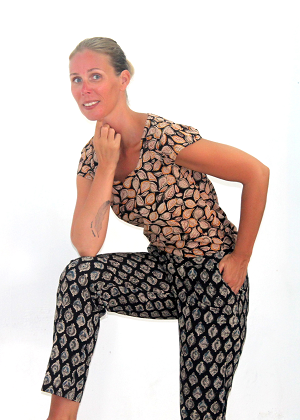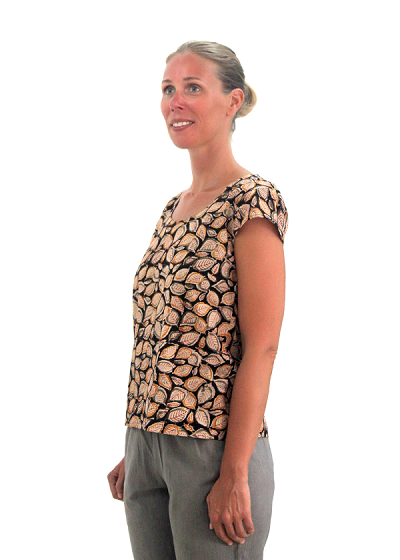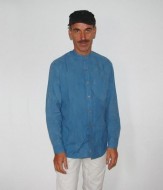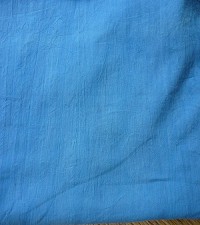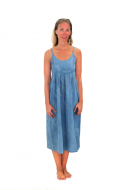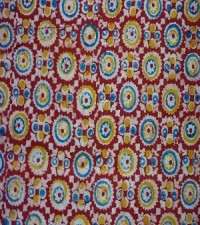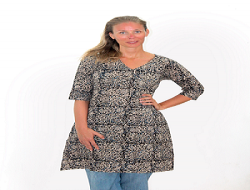U neck kalamkari printed Organic Cotton top/tunic
Home > Shop > Organic Cotton > U neck kalamkari printed Organic Cotton top/tunic
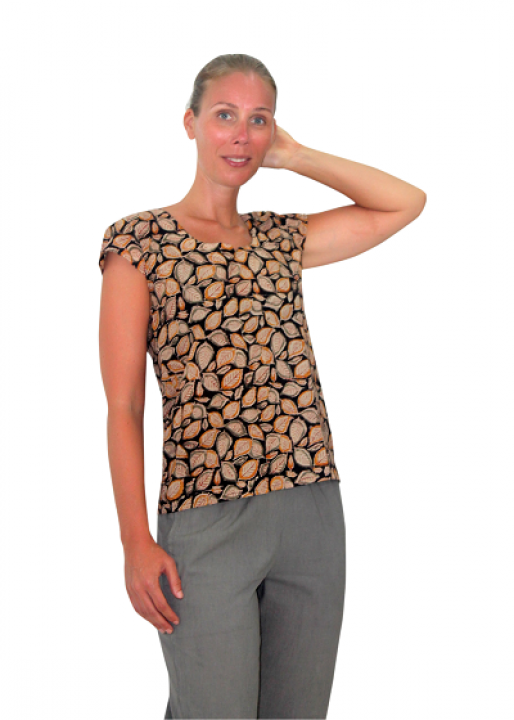
Kalamkari printed U-neck Kurthi/Tunic
Fabric: GOTS Certified Naturally dyed organic cotton (Kalamkari clothing)
Style: U neck Kurthi/Tunic
Size: M (L,XL,XXL available)
Dye/Print:Hand block printed Kalamkari
Gender: Female
Style: U neck Kurthi/Tunic
Sleeve: Short sleeve
Occasion: Casual/Formal
Eco friendly/Chemical free/fair trade throughout production processWashing Care:
Soap/Shampoo dissolve in water first.
Hand wash, wash separately,
To preserve the texture and colour of natural dyed organic cotton, it is -
highly recommended to wash with pure natural soap
Description
Kalamkari printing on Organic Cotton
Kalamkari is the earliest and most complex techniques of block printing on cloth using vegetables dyes. Historically the art of Kalamkari printing in India was wide spread from early times. Today Kalamkari printing is found in a few very rural areas. Kalamkari printing is the best specimen of natural colour artwork. The artisans only use natural colours extracted from bark, flower and roots of plants. No chemical dyes are used to achieve the spectrum of Kalamkari colours. The vibrancy of the colours achieved from natural ingredients is quite amazing. The red colour is obtained by using the Indian madder root, Yellow from the pomegranate seed or even mango bark and Black from Myrobalan fruit.
We use only organic cotton for Kalamkari printing. The production process is complex and intricate. The blocks have very detailed and elaborate designs and are hand carved by specialist artisans. These blocks are used to produce beautiful block printed fabric which can then be used to manufacture table linen, curtains, blankets and a variety of clothing etc.
The following are the main stages in the production process.
1. Block making
2. Initial preparation of cloth for Kalamkari process.
3. Formulation of starch.
4. Mordanting of cloth in mayrobalan solution
5. Outline of block printing.
6. Filling in colours, printing pads.
7. Bleaching and washing
8. Starching
9. Degumming and washing
10. Cleaning of cloth and application of alum solution
11. Soaping and finishing (final process) the colour fastness is ensured by the Washing, bleaching and sunning processes.
Organic cotton (Naturally dyed) Organic cotton
Organic cotton is understood to be cotton that is grown in subtropical climate and does not use genetically modified plants. It is grown without the use of any synthetic agricultural fertilizers or pesticides.
The production of Cotton covers 2.5% of the worlds cultivated land yet uses more than 16% of the worlds insecticides. This is significantly more than any other major crop and gives growing cause for concern both for the individual and the environment.
There are major disadvantages and consequences in using of non-organically produced cotton as the chemicals involved can cause skin irritation and inflammation. There are also global implications of decreased biodiversity and shifting the equilibrium of eco systems due to the prolonged use of pesticides.
For the reasons outlined above the popularity of organically produced Cotton is on the increase. Support and investment for producers, who avoid the use of pesticides, herbicides or artificial fertilizers, should be the way forward as Organic Cotton is the way to protect our environment, which in turn benefits our health and happiness. It also produces a fabric which is softer to the skin.
We use two different dying methods for organic cotton fabric. Our plain dyed fabric is produced using the Ayurvastra method. This uses herb to colour the fabric. Our patterned fabric is hand block printed using Kalamkari technique.
Kalamkari printed U-neck Kurthi/Tunic
Fabric: GOTS Certified Naturally dyed organic cotton (Kalamkari clothing)
Style: U neck Kurthi/Tunic
Size: M (L,XL,XXL available)
Dye/Print:Hand block printed Kalamkari
Gender: Female
Style: U neck Kurthi/Tunic
Sleeve: Short sleeve
Occasion: Casual/Formal
Eco friendly/Chemical free/fair trade throughout production processWashing Care:
Soap/Shampoo dissolve in water first.
Hand wash, wash separately,
To preserve the texture and colour of natural dyed organic cotton, it is -
highly recommended to wash with pure natural soap
Description
Kalamkari printing on Organic Cotton
Kalamkari is the earliest and most complex techniques of block printing on cloth using vegetables dyes. Historically the art of Kalamkari printing in India was wide spread from early times. Today Kalamkari printing is found in a few very rural areas. Kalamkari printing is the best specimen of natural colour artwork. The artisans only use natural colours extracted from bark, flower and roots of plants. No chemical dyes are used to achieve the spectrum of Kalamkari colours. The vibrancy of the colours achieved from natural ingredients is quite amazing. The red colour is obtained by using the Indian madder root, Yellow from the pomegranate seed or even mango bark and Black from Myrobalan fruit.
We use only organic cotton for Kalamkari printing. The production process is complex and intricate. The blocks have very detailed and elaborate designs and are hand carved by specialist artisans. These blocks are used to produce beautiful block printed fabric which can then be used to manufacture table linen, curtains, blankets and a variety of clothing etc.
The following are the main stages in the production process.
1. Block making
2. Initial preparation of cloth for Kalamkari process.
3. Formulation of starch.
4. Mordanting of cloth in mayrobalan solution
5. Outline of block printing.
6. Filling in colours, printing pads.
7. Bleaching and washing
8. Starching
9. Degumming and washing
10. Cleaning of cloth and application of alum solution
11. Soaping and finishing (final process) the colour fastness is ensured by the Washing, bleaching and sunning processes.
Organic cotton (Naturally dyed) Organic cotton
Organic cotton is understood to be cotton that is grown in subtropical climate and does not use genetically modified plants. It is grown without the use of any synthetic agricultural fertilizers or pesticides.
The production of Cotton covers 2.5% of the worlds cultivated land yet uses more than 16% of the worlds insecticides. This is significantly more than any other major crop and gives growing cause for concern both for the individual and the environment.
There are major disadvantages and consequences in using of non-organically produced cotton as the chemicals involved can cause skin irritation and inflammation. There are also global implications of decreased biodiversity and shifting the equilibrium of eco systems due to the prolonged use of pesticides.
For the reasons outlined above the popularity of organically produced Cotton is on the increase. Support and investment for producers, who avoid the use of pesticides, herbicides or artificial fertilizers, should be the way forward as Organic Cotton is the way to protect our environment, which in turn benefits our health and happiness. It also produces a fabric which is softer to the skin.
We use two different dying methods for organic cotton fabric. Our plain dyed fabric is produced using the Ayurvastra method. This uses herb to colour the fabric. Our patterned fabric is hand block printed using Kalamkari technique.
ID:U neck kalamkari printed Organic Cotton top/tunic
Organic Cotton,
Rs
1100
